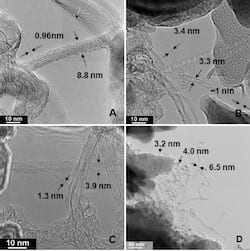NEWS RELEASE
Mike Williams
713-348-6728
mikewilliams@rice.edu
All the nanotubes are fit to print
Rice, Swansea chemists use newsprint for inexpensive bulk production of carbon nanotubes
HOUSTON – (Nov. 27, 2019) – Read all about this, carbon nanotube fans. Researchers at Rice and Swansea universities have developed a technique to use inexpensive newsprint harvested from newspapers to grow nanotubes for industry.
A study initiated by late Rice researcher Robert Hauge and continued by research scientists Bruce Brinson and Varun Shenoy Gangoli and chemist Andrew Barron showed a particular kind of newsprint can be treated to serve as a three-dimensional substrate for single-walled carbon nanotube growth.

Transmission electron microscope images of raw carbon soot grown on kaolin-sized newsprint shows (a) roped single-walled carbon nanotubes, and (b) collapsed, (c) folded and (d) twisted nanotubes. Courtesy of Bruce Brinson
“Stacked newsprint that incorporates kaolin clay and used as the catalyst-bearing substrate is a low- cost, very high surface-area growth medium compatible with continuous-flow production methods,” Brinson said.
Not all newsprint is created equal, since only that produced with kaolin (china clay) sizing allowed for carbon nanotube growth. Sizing is a filler incorporated into paper to change its absorption, color and wear characteristics. The researchers found that kaolin facilitates the reduction of iron to nanoscale catalyst particles that minimize the aggregation of nanotubes in the final product.
“Our observation that kaolin sizing, and not calcium carbonate sizing, offers insight into how the growth catalyst — in our case, iron — is affected by the chemical nature of the substrate,” said Barron, director of the Energy Safety Research Institute (ESRI) at Swansea.
One newspaper tested for nanotube growth, the Rice Thresher, was unsuitable, the researchers found. For those that worked, only the parts without ink served the purpose, limiting lab studies to sections trimmed from the papers’ edges.

Rice University research scientist Bruce Brinson led a study that turned the unprinted parts of old newspapers into a substrate for carbon nanotube growth.
Brinson estimated kaolin is part of 60% of the world’s paper products. “It’s whiter and brighter than most,” he said. “A key to newsprint is that it is thin, cheap and light. We only need the surface; the bulk between the front and back surfaces doesn’t count for much.”
The opportunity to prepare the substrate in bulk differentiates newsprint from traditional chemical vapor deposition substrates, Brinson said. He said the process promises to reduce the use of toxic materials and greenhouse gases in the bulk nanotube growth.
Brinson is the lead author on this work. Co-authors of the paper are Rice research manager Anjli Kumar and adjunct faculty member Wade Adams, former director of Rice’s Smalley Institute for Nanoscale Science and Technology. Barron is the Sêr Cymru Chair of Low Carbon Energy and Environment and professor emeritus of chemistry and materials science and nanoengineering at Rice.
The Office of Naval Research supported the research.
-30-
Read the abstract at https://chemistry.rice.edu
Follow Rice News and Media Relations via Twitter @RiceUNews
Related materials:
Rice University Department of Chemistry: https://chemistry.rice.edu
ESRI: http://www.esri-swansea.org/en/
Image for download:
https://news2.rice.edu/files/2019/11/1125_NEWSPRINT-1-web.jpg
Transmission electron microscope images of raw carbon soot grown on kaolin-sized newsprint shows (a) roped single-walled carbon nanotubes, and (b) collapsed, (c) folded and (d) twisted nanotubes. (Credit: Bruce Brinson/Rice University)
https://news2.rice.edu/files/2019/11/1125_NEWSPRINT-2-web-1.jpg
Rice University research scientist Bruce Brinson led a study that turned the unprinted parts of old newspapers into a substrate for carbon nanotube growth. (Credit: Rice University)
Located on a 300-acre forested campus in Houston, Rice University is consistently ranked among the nation’s top 20 universities by U.S. News and World Report. Rice has highly respected schools of Architecture, Business, Continuing Studies, Engineering, Humanities, Music, Natural Sciences and Social Sciences and is home to the Baker Institute for Public Policy. With 3,962 undergraduates and 3,027 graduate students, Rice’s undergraduate student-to-faculty ratio is just under 6-to-1. Its residential college system builds close-knit communities and lifelong friendships, just one reason why Rice is ranked No. 1 for lots of race/class interaction and No. 4 for quality of life by the Princeton Review. Rice is also rated as a best value among private universities by Kiplinger’s Personal Finance.



